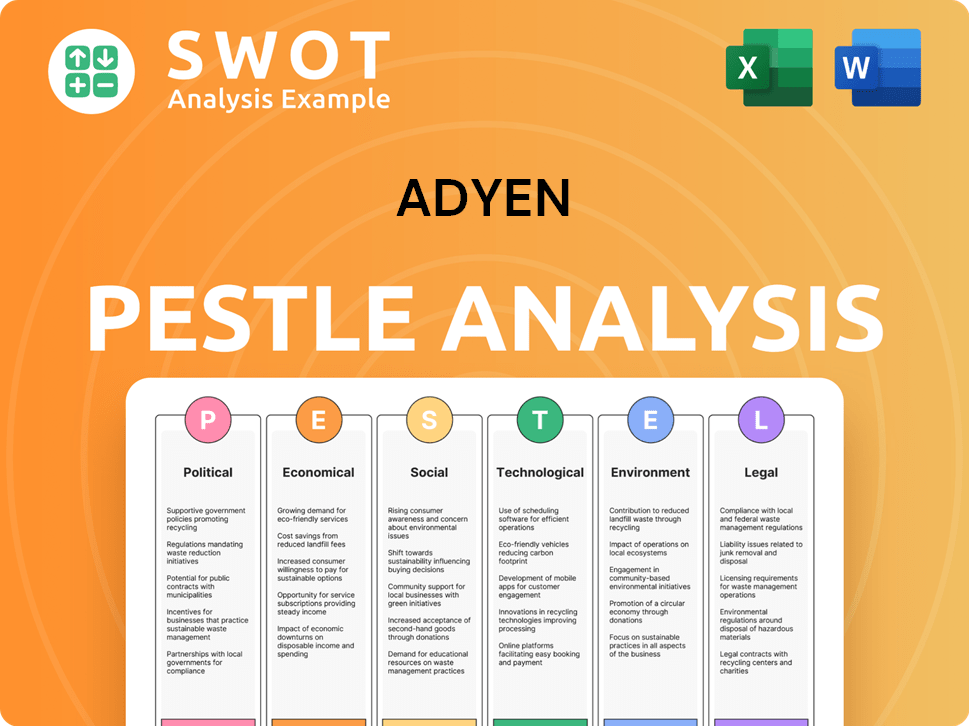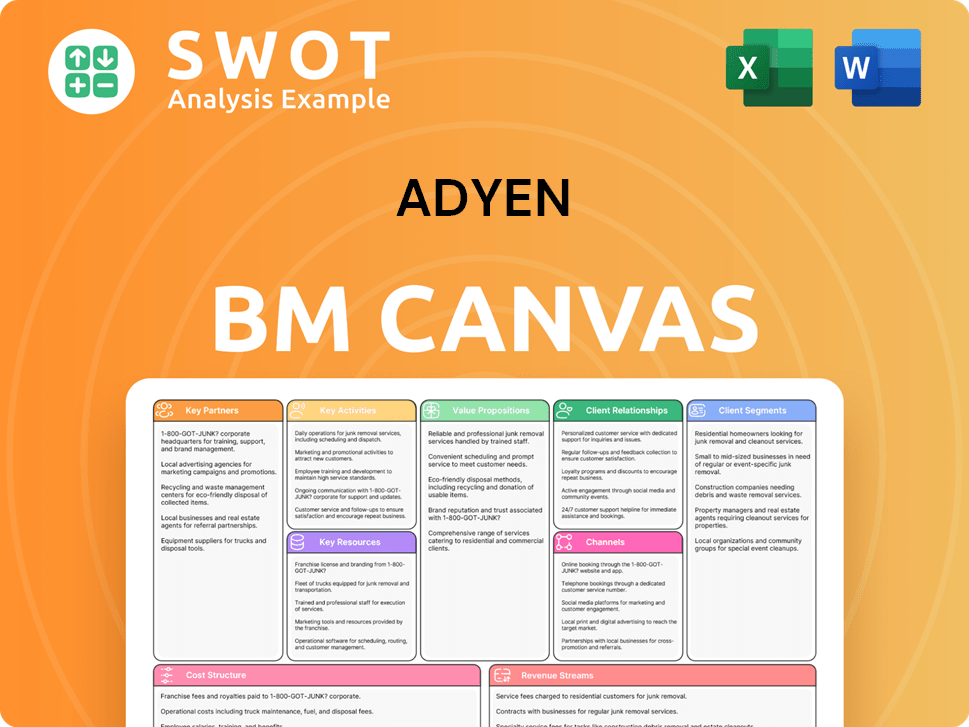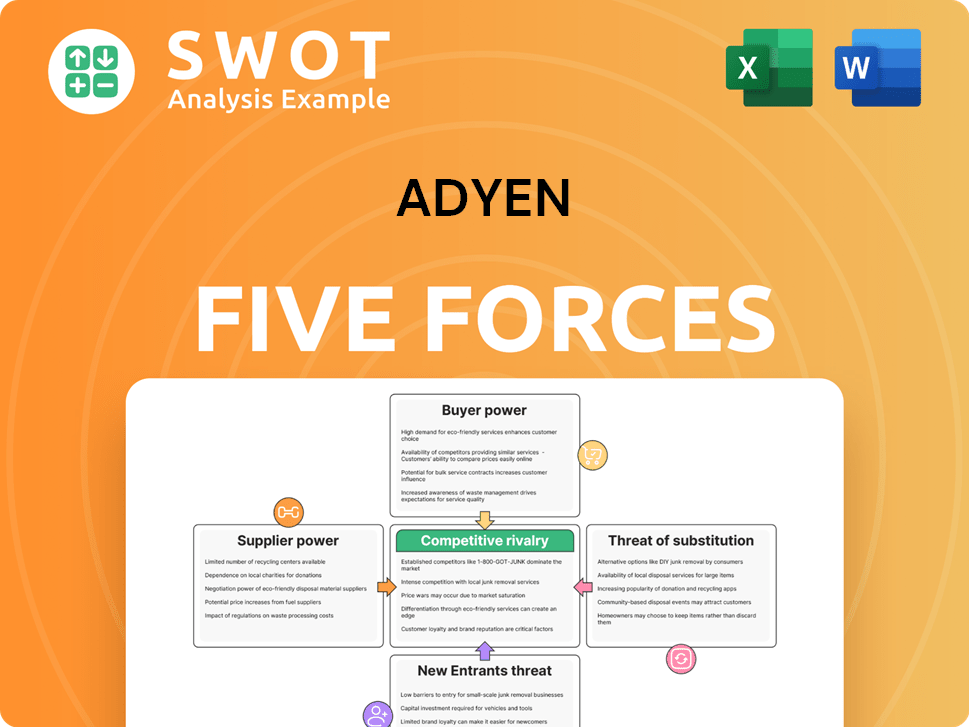Adyen Bundle
Who Really Controls the Fintech Giant Adyen?
Unraveling the Adyen SWOT Analysis is just the beginning; understanding the company's ownership is key to grasping its future. Founded in Amsterdam in 2006, Adyen revolutionized the payments landscape with a single, unified platform. But who holds the reins of this financial technology powerhouse, and how has its ownership evolved?

From its inception by Pieter van der Does and Arnout Schuijff to its 2018 IPO, the Adyen company has seen significant shifts in its Adyen ownership structure. This exploration will dissect the influence of Adyen investors, the roles of Adyen executives, and the impact of its public listing on its strategic direction. Discover the answers to questions like "Who are the major shareholders of Adyen?" and "Who controls Adyen?" to gain a comprehensive understanding of its corporate governance and long-term vision.
Who Founded Adyen?
The story of Adyen begins with a team of experienced entrepreneurs who had previously built and sold Bibit, a payment processor, to the Royal Bank of Scotland. This background provided a strong foundation for their next venture. The founders' prior success and industry knowledge were critical in shaping Adyen's early strategy and attracting initial investment.
Pieter van der Does and Arnout Schuijff are the key founders of the Adyen company. Van der Does serves as the CEO, while Schuijff, who was the CTO for many years, remains a significant figure. Their vision for a global payment platform was central to the company's early development. While the exact initial equity splits are not publicly available, it is common for founders to hold substantial control in the early stages.
Early backers and angel investors played a crucial role in the initial funding rounds, providing the capital needed to develop the platform and expand operations. These early investors likely acquired stakes through seed funding and Series A rounds, contributing to the company's growth before its public offering. The founders' vision for a streamlined, global payment platform was central to attracting these initial investments. There is no widely publicized information regarding initial ownership disputes or significant founder buyouts in Adyen's early history, suggesting a relatively stable founding team dynamic.
Founders Pieter van der Does and Arnout Schuijff had previous experience with Bibit, a payment processor. Their prior success was key to Adyen's early strategy.
Pieter van der Does is the CEO, and Arnout Schuijff is a significant figure. Their vision shaped Adyen's technological foundation.
Angel investors and early backers provided capital for platform development and expansion. Seed and Series A rounds were crucial for growth.
There is no public information about initial ownership disputes or significant founder buyouts. This suggests a stable founding team dynamic.
Specific initial equity splits or precise shareholding percentages at the company's inception are not publicly detailed.
The founders' vision for a streamlined, global payment platform was central to attracting these initial investments and shaping the early distribution of control.
Understanding the early ownership of the Adyen company is key to grasping its trajectory. The founders, Pieter van der Does and Arnout Schuijff, held significant initial control. Early investors played a crucial role in funding the company's growth. For a deeper dive into the competitive landscape, consider reading about the Competitors Landscape of Adyen.
- Pieter van der Does: CEO and co-founder.
- Arnout Schuijff: CTO and co-founder, significant figure.
- Early investors: Provided capital through seed and Series A rounds.
- Ownership stability: No public disputes or buyouts in early history.
Adyen SWOT Analysis
- Complete SWOT Breakdown
- Fully Customizable
- Editable in Excel & Word
- Professional Formatting
- Investor-Ready Format

How Has Adyen’s Ownership Changed Over Time?
The Adyen company experienced a pivotal shift in its ownership structure with its Initial Public Offering (IPO) on June 13, 2018, on the Euronext Amsterdam exchange. This transition from a private to a public entity was marked by an initial valuation of approximately €7.1 billion, with shares priced at €240 each. The IPO significantly broadened its ownership base, introducing institutional investors and public shareholders.
Post-IPO, the ownership of Adyen evolved to include a mix of institutional investors, mutual funds, and individual insiders. Founders Pieter van der Does and Arnout Schuijff maintained substantial stakes, though their ownership percentages diluted as new shares were issued. As of late 2024 and early 2025, major asset management firms and investment funds hold significant portions of Adyen's shares, with institutional ownership often exceeding 50% of the outstanding shares. This transition has increased scrutiny and transparency, influencing Adyen's strategic decisions and corporate governance.
Adyen's ownership structure changed significantly with its IPO in 2018, transforming it into a publicly traded company.
- The IPO valued the company at approximately €7.1 billion.
- Major shareholders now include institutional investors and founders.
- Institutional ownership often exceeds 50% of outstanding shares.
- The shift to public ownership increased scrutiny and transparency.
Adyen PESTLE Analysis
- Covers All 6 PESTLE Categories
- No Research Needed – Save Hours of Work
- Built by Experts, Trusted by Consultants
- Instant Download, Ready to Use
- 100% Editable, Fully Customizable

Who Sits on Adyen’s Board?
The Board of Directors at the Adyen company, as of early 2025, is structured to blend founder influence, major shareholder representation, and independent expertise. The board typically includes executive directors, such as CEO Pieter van der Does, reflecting the founding vision and significant ownership. Non-executive directors often represent major institutional investors or bring experience from finance and technology, ensuring independent oversight of the company. This structure is crucial for guiding Adyen's strategic direction and ensuring good corporate governance.
The composition of the board is designed to support Adyen's growth and stability. The presence of both executive and non-executive directors helps in balancing operational insights with independent perspectives. This balance is essential for making informed decisions and navigating the complexities of the financial technology sector. The board's role is vital in overseeing the company's performance and ensuring it aligns with the interests of all stakeholders. The board's structure supports the company's long-term strategy and operational excellence.
| Board Member | Role | Background |
|---|---|---|
| Pieter van der Does | CEO and Executive Director | Co-founder of Adyen |
| Ingrid Van de Voort | Non-Executive Director | Extensive experience in financial services |
| Joanna Lambert | Non-Executive Director | Expertise in technology and e-commerce |
Adyen operates with a one-share-one-vote structure for its ordinary shares. This approach means each share has equal voting power. This governance model is more democratic compared to companies with dual-class shares. Although founders like Pieter van der Does hold a significant number of shares, their control comes from their ownership stake rather than special voting rights. This structure helps maintain a stable governance environment, allowing the company to focus on its long-term growth. For more details on Adyen's business model, you can refer to Revenue Streams & Business Model of Adyen.
The Adyen company's ownership structure is designed to promote stability and align the interests of all shareholders. The one-share-one-vote system ensures that all shareholders have equal voting rights.
- The founders maintain a significant ownership stake.
- Major institutional investors also hold substantial shares.
- The board of directors oversees the company's strategic direction.
- The company's governance structure supports long-term growth.
Adyen Business Model Canvas
- Complete 9-Block Business Model Canvas
- Effortlessly Communicate Your Business Strategy
- Investor-Ready BMC Format
- 100% Editable and Customizable
- Clear and Structured Layout

What Recent Changes Have Shaped Adyen’s Ownership Landscape?
Over the past few years, from 2022 to early 2025, the ownership structure of the Adyen company has seen gradual shifts. The company, a prominent player in the fintech sector, has experienced the natural dilution of founder stakes as its market capitalization has grown. While there haven't been significant share buybacks or secondary offerings to drastically alter the ownership, the trading of shares has led to a more diverse shareholder base. The focus remains on organic growth and strategic partnerships, rather than major mergers or acquisitions that would significantly impact the ownership profile of Adyen.
Industry trends, such as the increasing influence of institutional investors and the rise of ESG (Environmental, Social, and Governance) investing, have likely played a role in shaping Adyen's ownership. Institutional investors are increasingly considering ESG factors in their investment decisions, which can subtly influence corporate governance and strategic priorities. Pieter van der Does, a key figure in Adyen's leadership, continues to ensure continuity with the company's foundational vision. Currently, there are no public plans for significant changes in the ownership control or any discussions about potential privatization. Adyen remains committed to its public listing on Euronext Amsterdam, focusing on sustained growth and market leadership in the global payments industry. Learn more about the Target Market of Adyen.
| Metric | Details (2024-2025) | Source |
|---|---|---|
| Institutional Ownership | Increased slightly, reflecting broader market trends. | Company filings, financial reports |
| Founder Dilution | Gradual decrease due to share trading. | Publicly available data |
| Market Capitalization | Fluctuating, but generally increasing. | Financial news sources |
The company’s commitment to its public listing on Euronext Amsterdam reflects its strategy for continued growth and market leadership. The absence of major ownership changes indicates a stable environment, with the focus remaining on expanding its global presence and enhancing its payment solutions. The ongoing involvement of key executives helps maintain the company's core values and strategic direction.
The ownership of Adyen is primarily influenced by institutional investors and the founders. The company's stock is publicly traded on Euronext Amsterdam. The ownership structure has seen gradual changes due to trading.
Major shareholders include institutional investors and the founders. The exact percentages change over time due to market activity. The company's leadership team, including the CEO, plays a vital role.
There have been no major announcements of significant share buybacks. Adyen focuses on organic growth and strategic partnerships. ESG factors influence investment decisions.
Adyen is committed to its public listing. The company is focused on sustained growth in the global payments industry. The leadership team is focused on maintaining the company's vision.
Adyen Porter's Five Forces Analysis
- Covers All 5 Competitive Forces in Detail
- Structured for Consultants, Students, and Founders
- 100% Editable in Microsoft Word & Excel
- Instant Digital Download – Use Immediately
- Compatible with Mac & PC – Fully Unlocked

Related Blogs
- What are Mission Vision & Core Values of Adyen Company?
- What is Competitive Landscape of Adyen Company?
- What is Growth Strategy and Future Prospects of Adyen Company?
- How Does Adyen Company Work?
- What is Sales and Marketing Strategy of Adyen Company?
- What is Brief History of Adyen Company?
- What is Customer Demographics and Target Market of Adyen Company?
Disclaimer
All information, articles, and product details provided on this website are for general informational and educational purposes only. We do not claim any ownership over, nor do we intend to infringe upon, any trademarks, copyrights, logos, brand names, or other intellectual property mentioned or depicted on this site. Such intellectual property remains the property of its respective owners, and any references here are made solely for identification or informational purposes, without implying any affiliation, endorsement, or partnership.
We make no representations or warranties, express or implied, regarding the accuracy, completeness, or suitability of any content or products presented. Nothing on this website should be construed as legal, tax, investment, financial, medical, or other professional advice. In addition, no part of this site—including articles or product references—constitutes a solicitation, recommendation, endorsement, advertisement, or offer to buy or sell any securities, franchises, or other financial instruments, particularly in jurisdictions where such activity would be unlawful.
All content is of a general nature and may not address the specific circumstances of any individual or entity. It is not a substitute for professional advice or services. Any actions you take based on the information provided here are strictly at your own risk. You accept full responsibility for any decisions or outcomes arising from your use of this website and agree to release us from any liability in connection with your use of, or reliance upon, the content or products found herein.